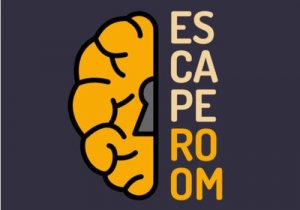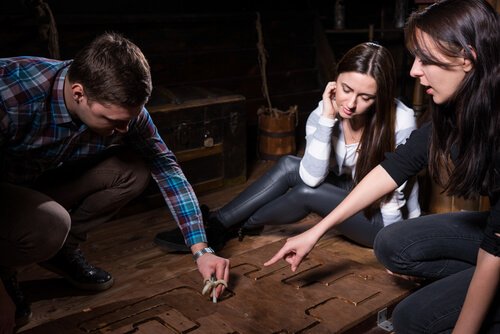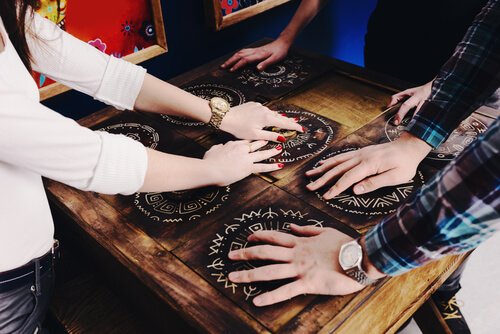Escape Rooms and Psychology

Escape rooms are a new trend in which psychology plays a fundamental role. In this game, a group of people who are locked in a room must find the key that will allow them to escape. They do so by following a series of clues and solving puzzles. They have a limited amount of time to find the key.
In this playful adventure, psychological processes combine with physical activity and social cooperation. In addition, these types of activities demonstrate how teamwork helps solve problems that couldn’t be solved by a single person (or at least not in a reasonable time). These tasks allow us to realize that we need to rely on other people and collaborate with each other.
Escape rooms improve team cooperation and communication.
What happens in an escape room?
Escape rooms transport us to a parallel universe where we are detectives and explorers. We start by listening to a story, a different one for each room. It takes only a few seconds for us to feel like the main characters in this adventure. Suddenly and almost without realizing it, we have a mission with our fellow teammates: to escape.
That’s when the game begins. We must find a way out of the room within 60 minutes. The clues can be anywhere: under tables, hidden in books, inside drawers with false bottoms, etc. A good strategy is distributing the tasks among the group members. Then, you can write down the dozens of clues that all of you find that will help the team progress.
Participating in escape rooms fosters self-confidence, increases self-esteem, promotes self-criticism, and encourages creativity.
Although escape rooms were initially conceived for adults, children 14 and up can participate as long as they’re accompanied by an adult. This makes escape rooms a great activity for players of different ages to enjoy together. There are also escape rooms exclusively for children.

The origin of escape rooms
Escape rooms originated in the first PC games. As an alternative to the low-graphic capacity of the first PCs, so-called conversational games were designed. Along with a simple still image, a situation or an interaction with a character was described in writing. At the end of each exhibition, various options appeared, which allowed players to make decisions based on the situations described. And based on the decisions the players made, the game took different directions.
Many of these conversational games were, in essence, escape games. You had to make the right decisions to save your life, save the princess’ life, escape from prison, or kill an evil foe. These games have evolved over time and, perhaps, they’ve also lost their essence due to the incredible graphics of today’s games.
However, the format of the game gained popularity again with the rise of smartphones. In Japan, live escape games took place in real rooms in 2008.
Escape rooms and psychology
But the first escape room opened its doors in Budapest, Hungary in 2011 thanks to Attila Gyurkovics. This Hungarian created a game called Parapark, in which a group of people had to find a way out of a room in a limited time.
Gyurkovic developed the escape room based on psychologist Mihaly Csikszentmihalyi’s flow.

Flow is a state in which a person is completely absorbed in an activity for their own pleasure or enjoyment. Time flies and actions, thoughts, and movements follow one another. Flow is when we strike a balance between the challenges of the task or activity and our skills for solving them.
The flow theory says that if we do an activity for our own enjoyment and experience a balance between our abilities and the challenges we’re facing, we enter a mental state where everything flows. At that moment, time seems to move very fast and ideas emerge freely in our minds.
“We would accomplish many more things if we did not think of them as impossible.”
-Vince Lombardi-
Flow in escape rooms
Many people say that they’ve started to feel flow, as described by Csikszentmihalyi’s flow theory, by participating in an escape room. Escape rooms are recreational spaces where the sole objective is for the players to have a good time and accept the challenge. Therefore, escape rooms are pleasurable in and of themselves, regardless of whether we succeed in finding the key or not.
Having to go through a process in which we feel immediate satisfaction with each success (finding a key to open a drawer, solving a puzzle, or opening a lock), satisfies us and encourages us to continue playing and focusing on the challenge at hand while all our worries disappear for a time.
“The secret of achievement is to hold a picture of a successful outcome in the mind.”
-Henry David Thoreau-
Escape rooms are a new trend in which psychology plays a fundamental role. In this game, a group of people who are locked in a room must find the key that will allow them to escape. They do so by following a series of clues and solving puzzles. They have a limited amount of time to find the key.
In this playful adventure, psychological processes combine with physical activity and social cooperation. In addition, these types of activities demonstrate how teamwork helps solve problems that couldn’t be solved by a single person (or at least not in a reasonable time). These tasks allow us to realize that we need to rely on other people and collaborate with each other.
Escape rooms improve team cooperation and communication.
What happens in an escape room?
Escape rooms transport us to a parallel universe where we are detectives and explorers. We start by listening to a story, a different one for each room. It takes only a few seconds for us to feel like the main characters in this adventure. Suddenly and almost without realizing it, we have a mission with our fellow teammates: to escape.
That’s when the game begins. We must find a way out of the room within 60 minutes. The clues can be anywhere: under tables, hidden in books, inside drawers with false bottoms, etc. A good strategy is distributing the tasks among the group members. Then, you can write down the dozens of clues that all of you find that will help the team progress.
Participating in escape rooms fosters self-confidence, increases self-esteem, promotes self-criticism, and encourages creativity.
Although escape rooms were initially conceived for adults, children 14 and up can participate as long as they’re accompanied by an adult. This makes escape rooms a great activity for players of different ages to enjoy together. There are also escape rooms exclusively for children.

The origin of escape rooms
Escape rooms originated in the first PC games. As an alternative to the low-graphic capacity of the first PCs, so-called conversational games were designed. Along with a simple still image, a situation or an interaction with a character was described in writing. At the end of each exhibition, various options appeared, which allowed players to make decisions based on the situations described. And based on the decisions the players made, the game took different directions.
Many of these conversational games were, in essence, escape games. You had to make the right decisions to save your life, save the princess’ life, escape from prison, or kill an evil foe. These games have evolved over time and, perhaps, they’ve also lost their essence due to the incredible graphics of today’s games.
However, the format of the game gained popularity again with the rise of smartphones. In Japan, live escape games took place in real rooms in 2008.
Escape rooms and psychology
But the first escape room opened its doors in Budapest, Hungary in 2011 thanks to Attila Gyurkovics. This Hungarian created a game called Parapark, in which a group of people had to find a way out of a room in a limited time.
Gyurkovic developed the escape room based on psychologist Mihaly Csikszentmihalyi’s flow.

Flow is a state in which a person is completely absorbed in an activity for their own pleasure or enjoyment. Time flies and actions, thoughts, and movements follow one another. Flow is when we strike a balance between the challenges of the task or activity and our skills for solving them.
The flow theory says that if we do an activity for our own enjoyment and experience a balance between our abilities and the challenges we’re facing, we enter a mental state where everything flows. At that moment, time seems to move very fast and ideas emerge freely in our minds.
“We would accomplish many more things if we did not think of them as impossible.”
-Vince Lombardi-
Flow in escape rooms
Many people say that they’ve started to feel flow, as described by Csikszentmihalyi’s flow theory, by participating in an escape room. Escape rooms are recreational spaces where the sole objective is for the players to have a good time and accept the challenge. Therefore, escape rooms are pleasurable in and of themselves, regardless of whether we succeed in finding the key or not.
Having to go through a process in which we feel immediate satisfaction with each success (finding a key to open a drawer, solving a puzzle, or opening a lock), satisfies us and encourages us to continue playing and focusing on the challenge at hand while all our worries disappear for a time.
“The secret of achievement is to hold a picture of a successful outcome in the mind.”
-Henry David Thoreau-
All cited sources were thoroughly reviewed by our team to ensure their quality, reliability, currency, and validity. The bibliography of this article was considered reliable and of academic or scientific accuracy.
Heikkinen, Outi and Julia Shumeyko. “Designing an escape room with the Experience Pyramid model.” Haaga-Helia University of Applied Sciences. 2016. https://www.theseus.fi/bitstream/handle/10024/112798/Thesis-Heikkinen-Shumeyko.pdf?sequence=1
This text is provided for informational purposes only and does not replace consultation with a professional. If in doubt, consult your specialist.







